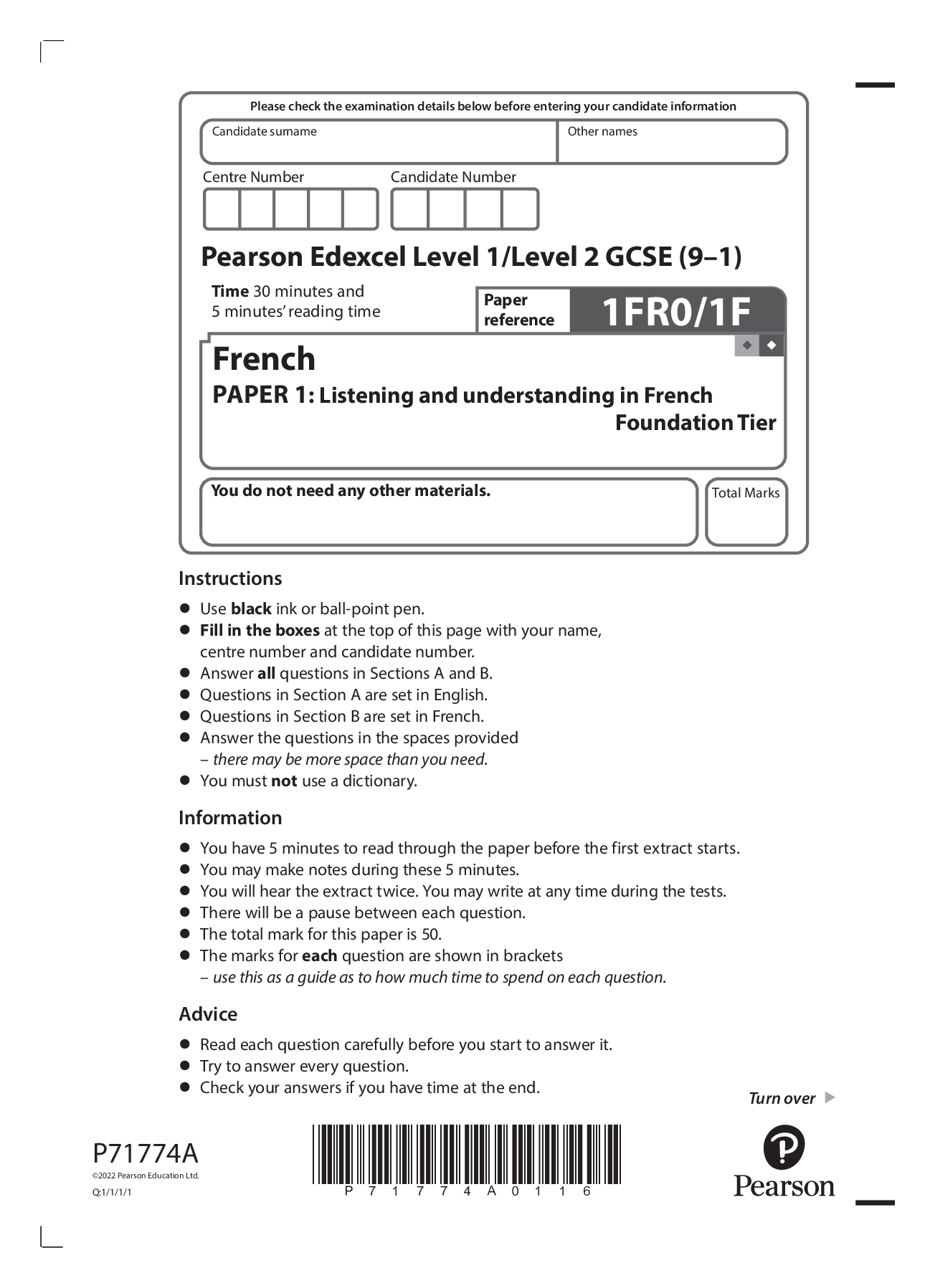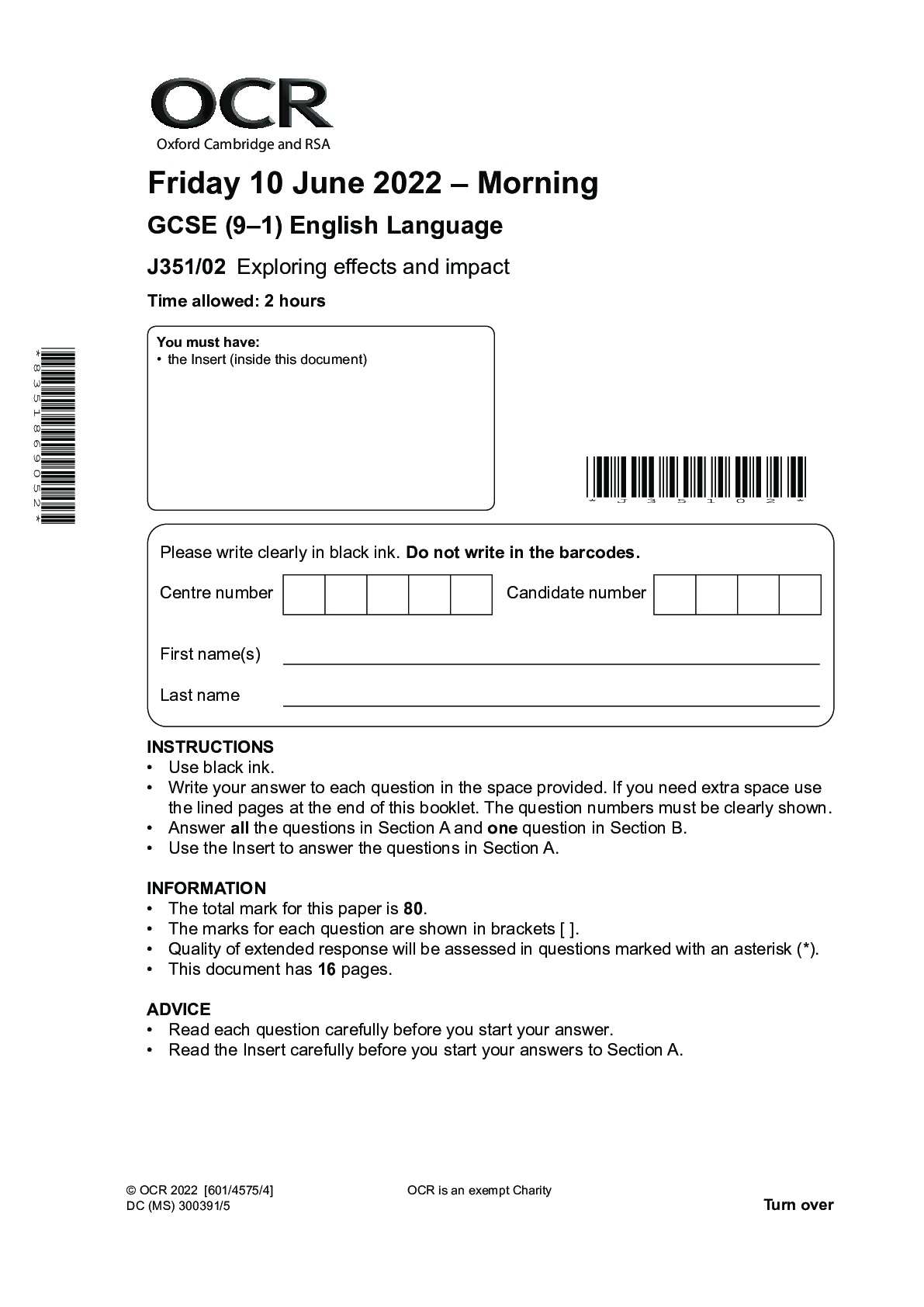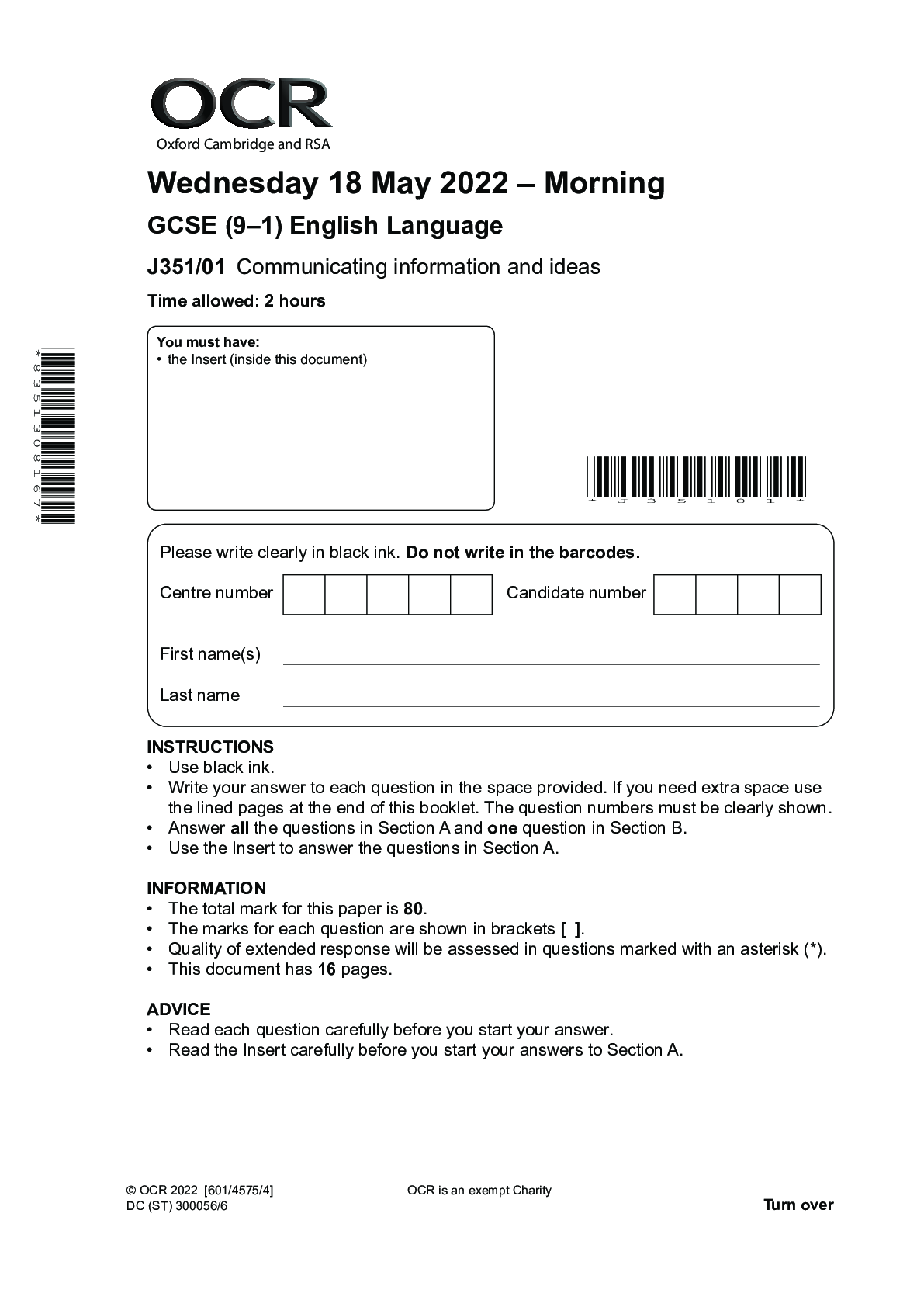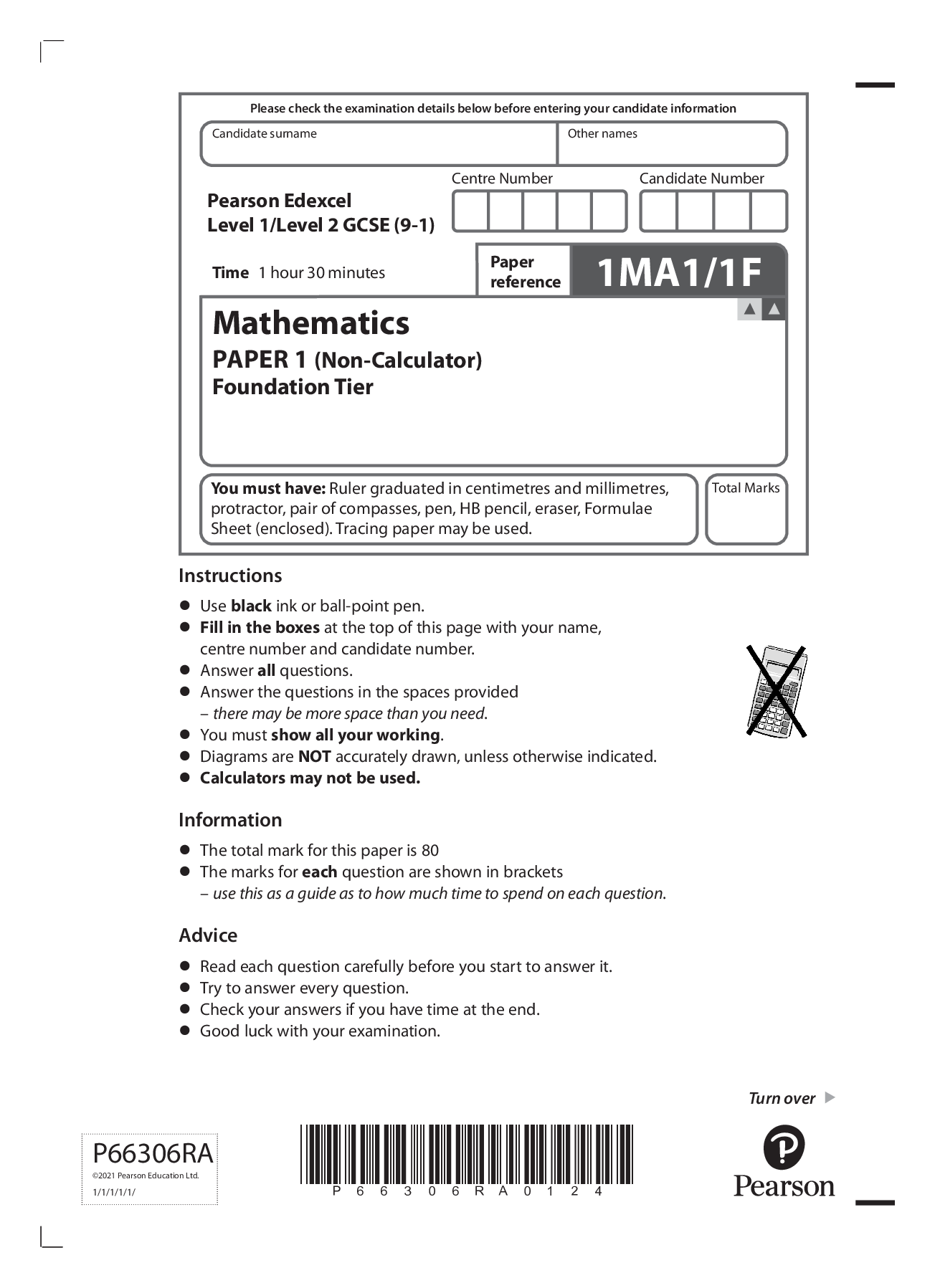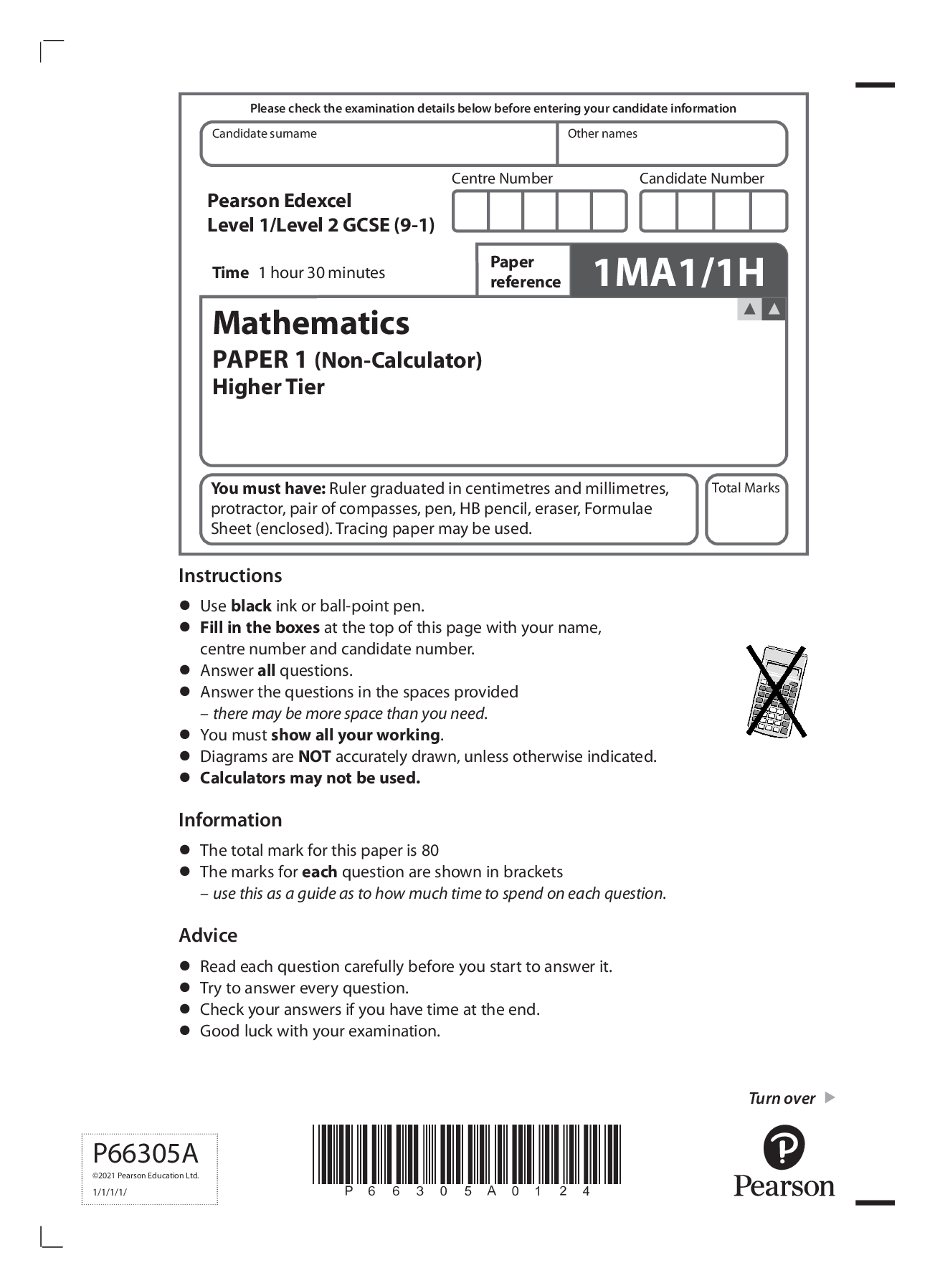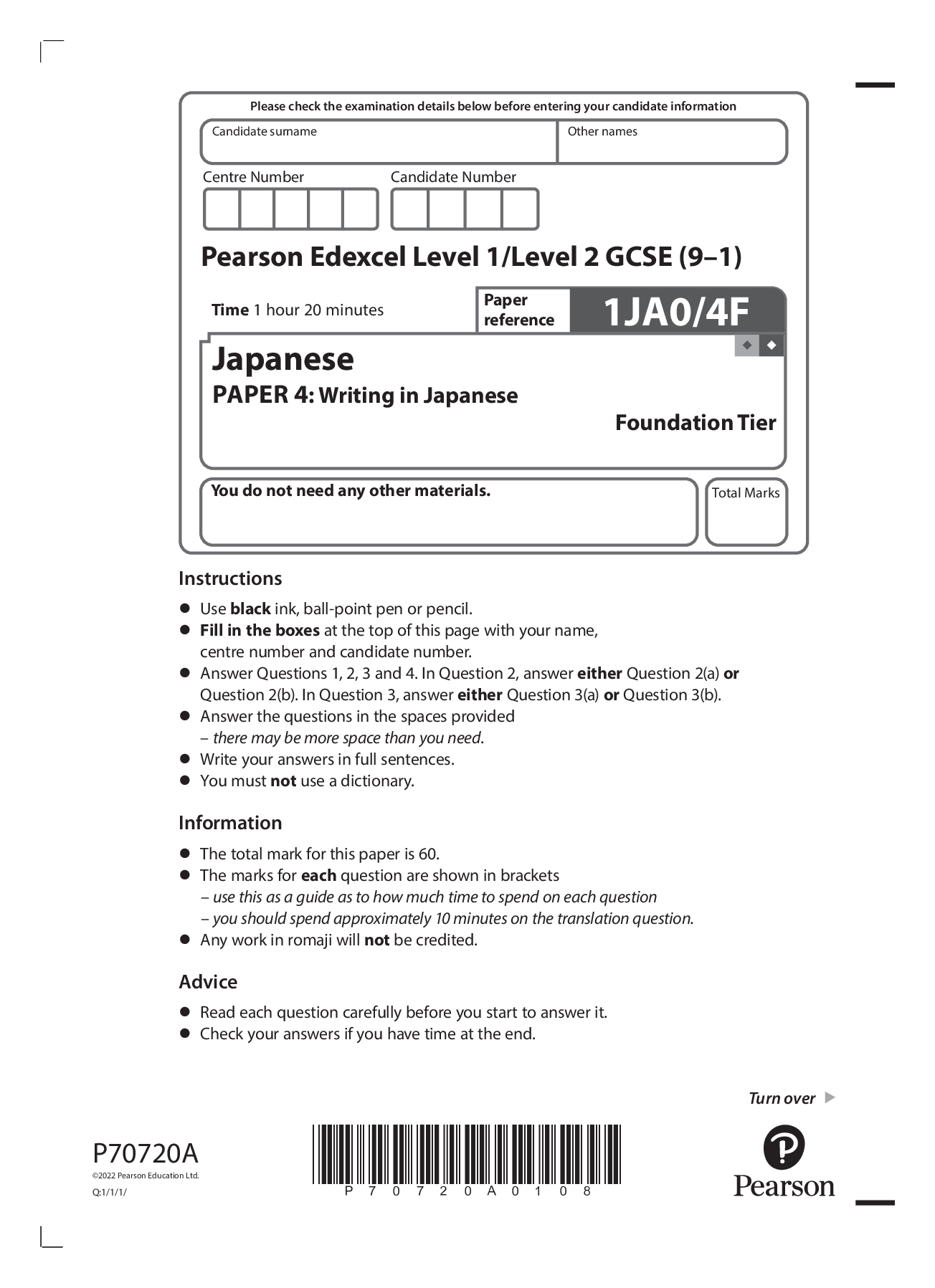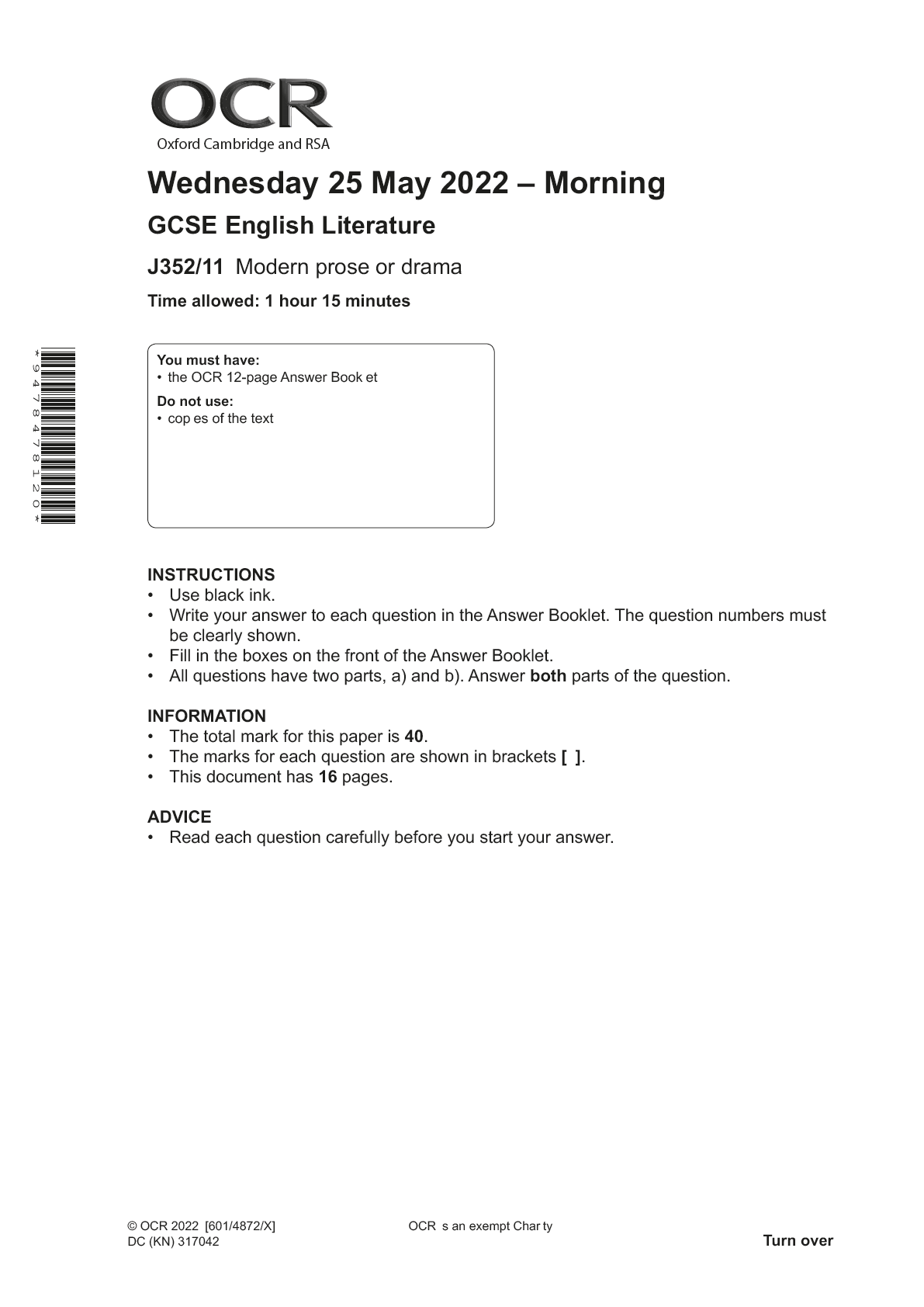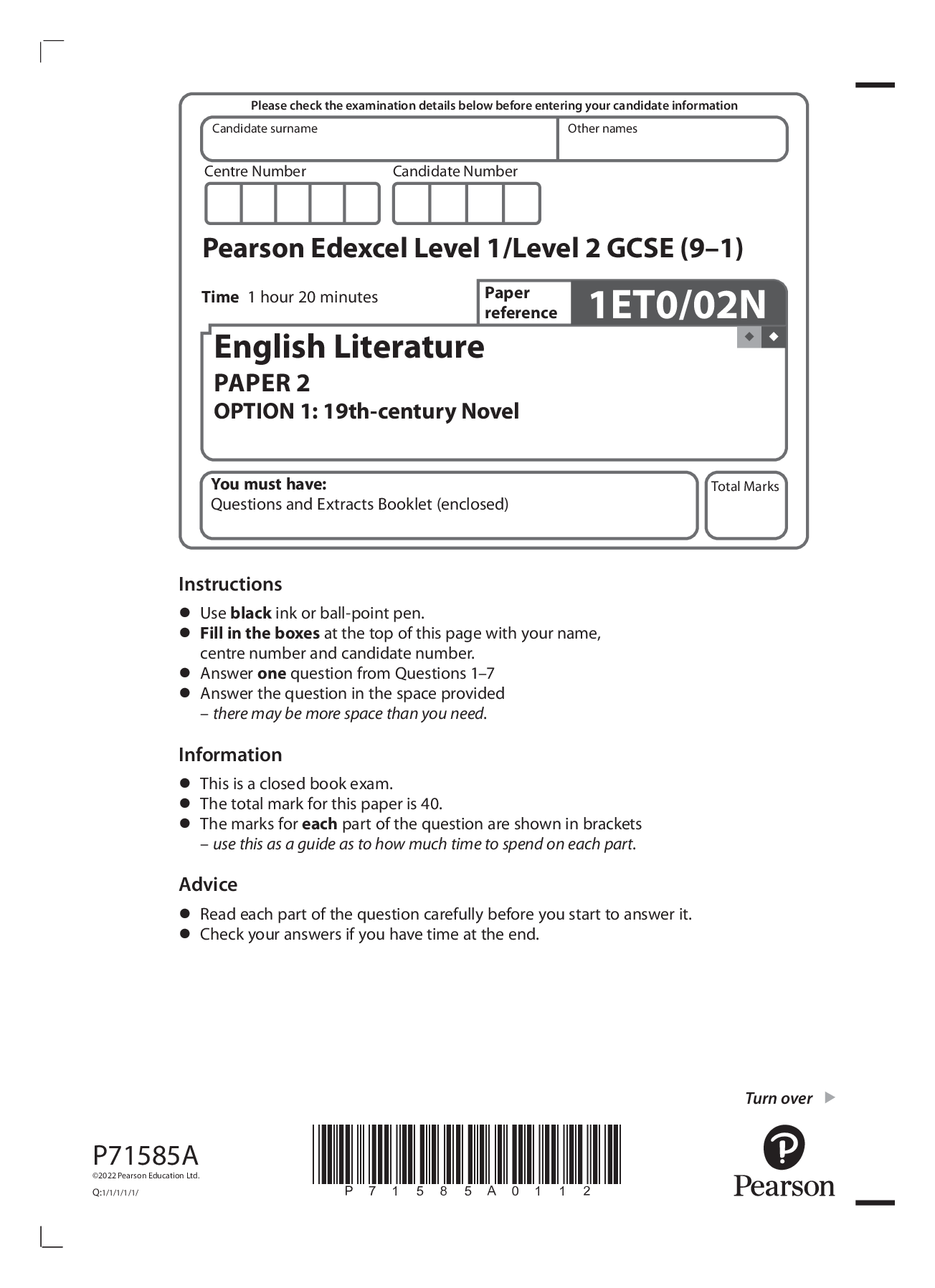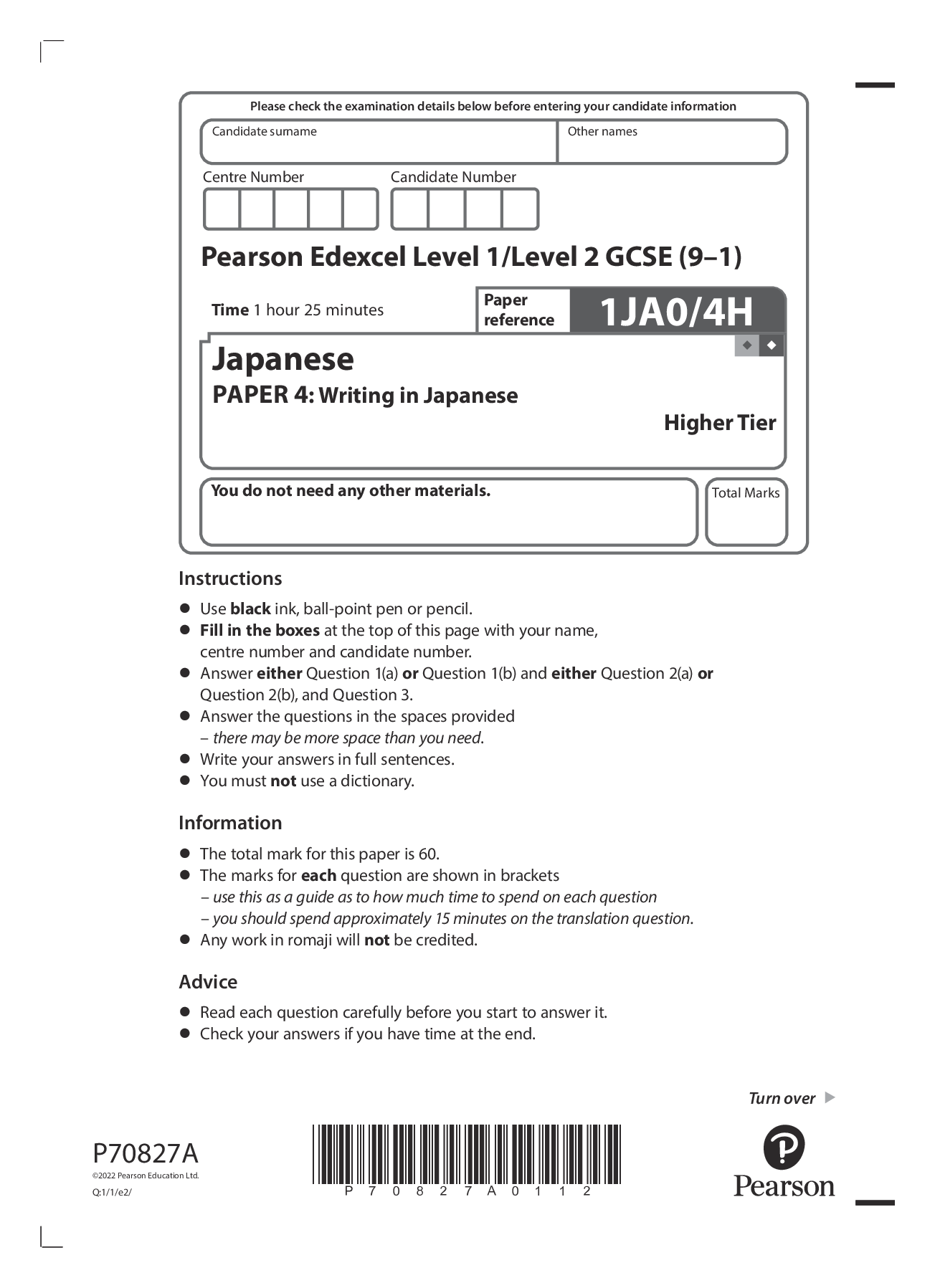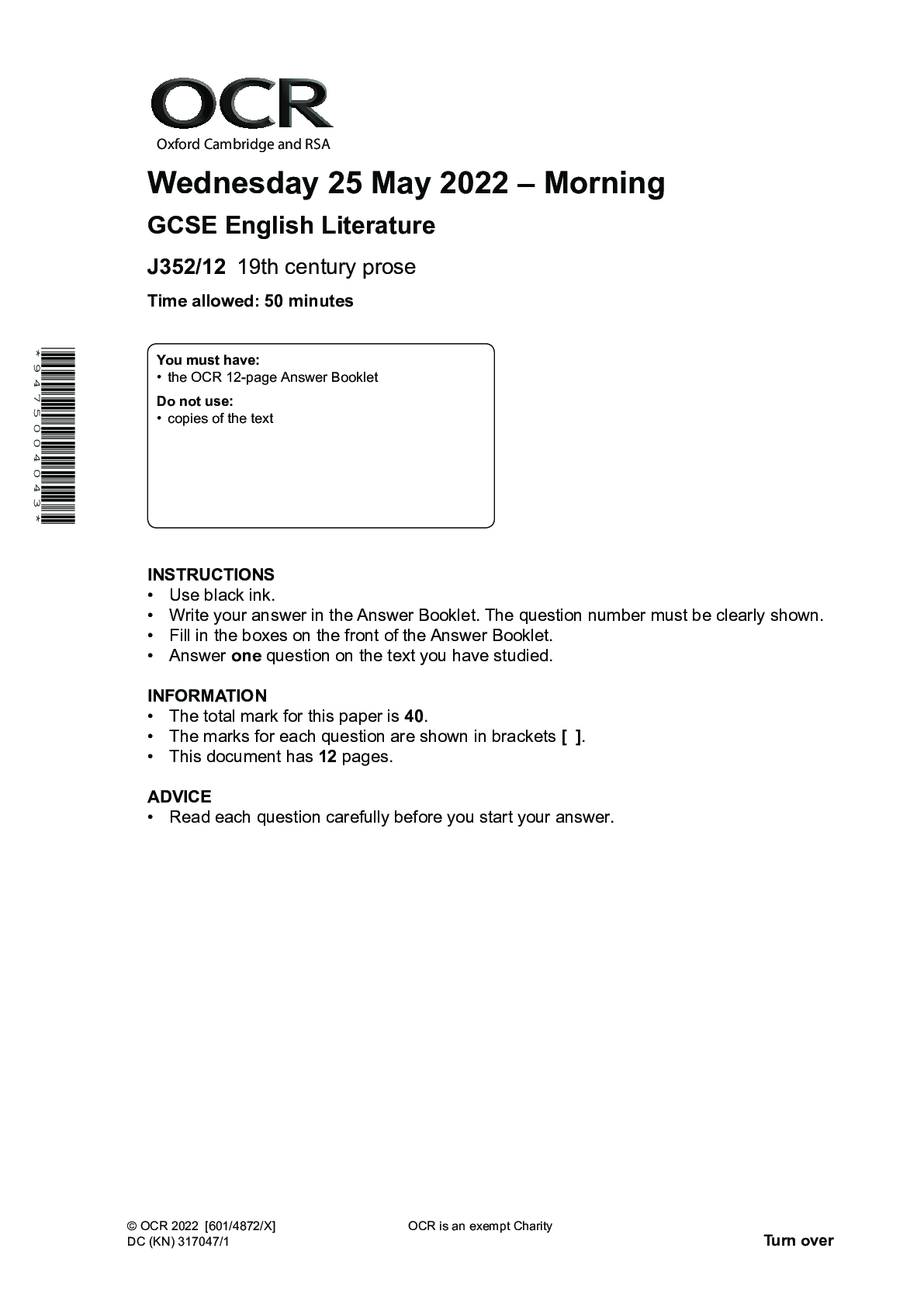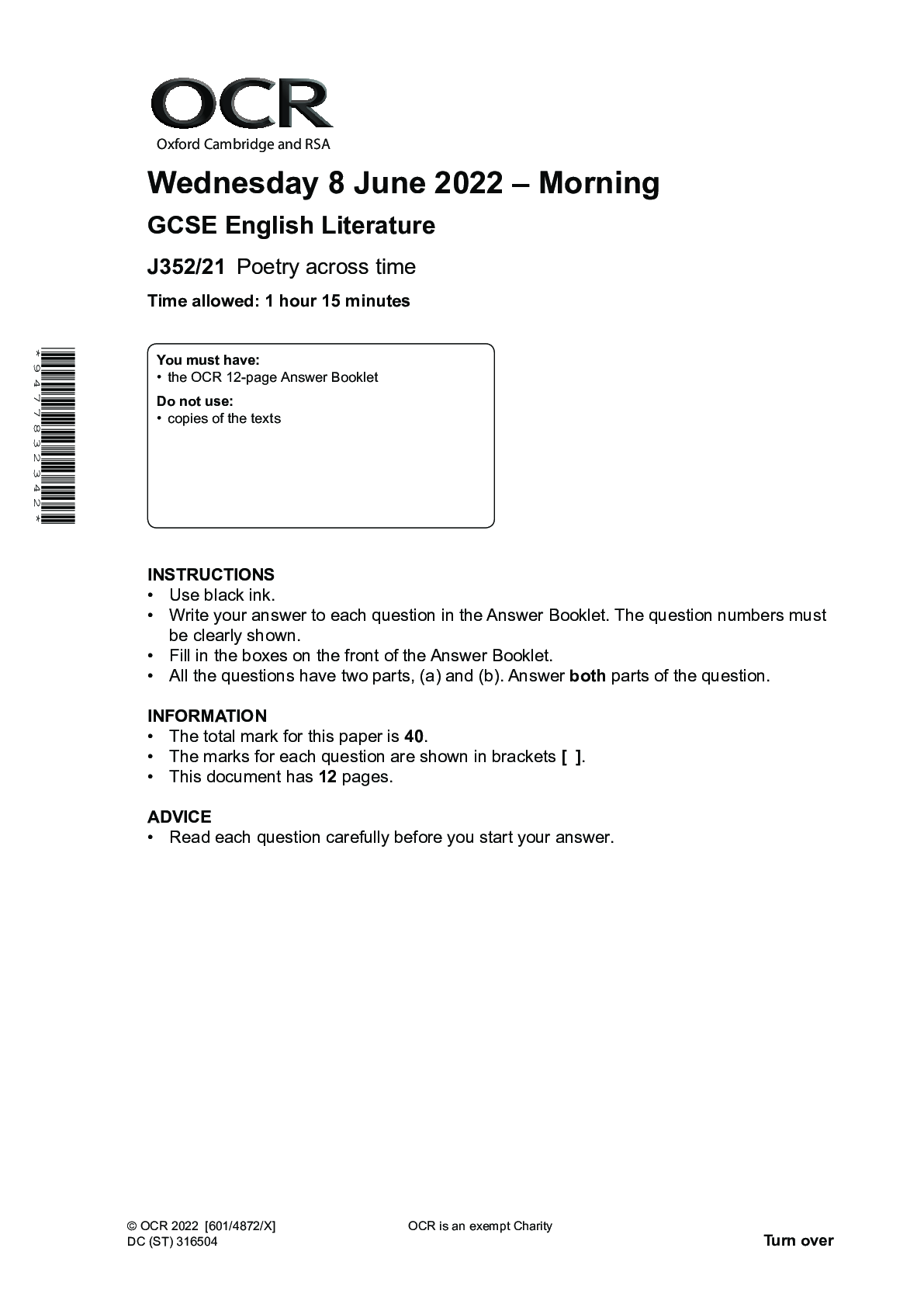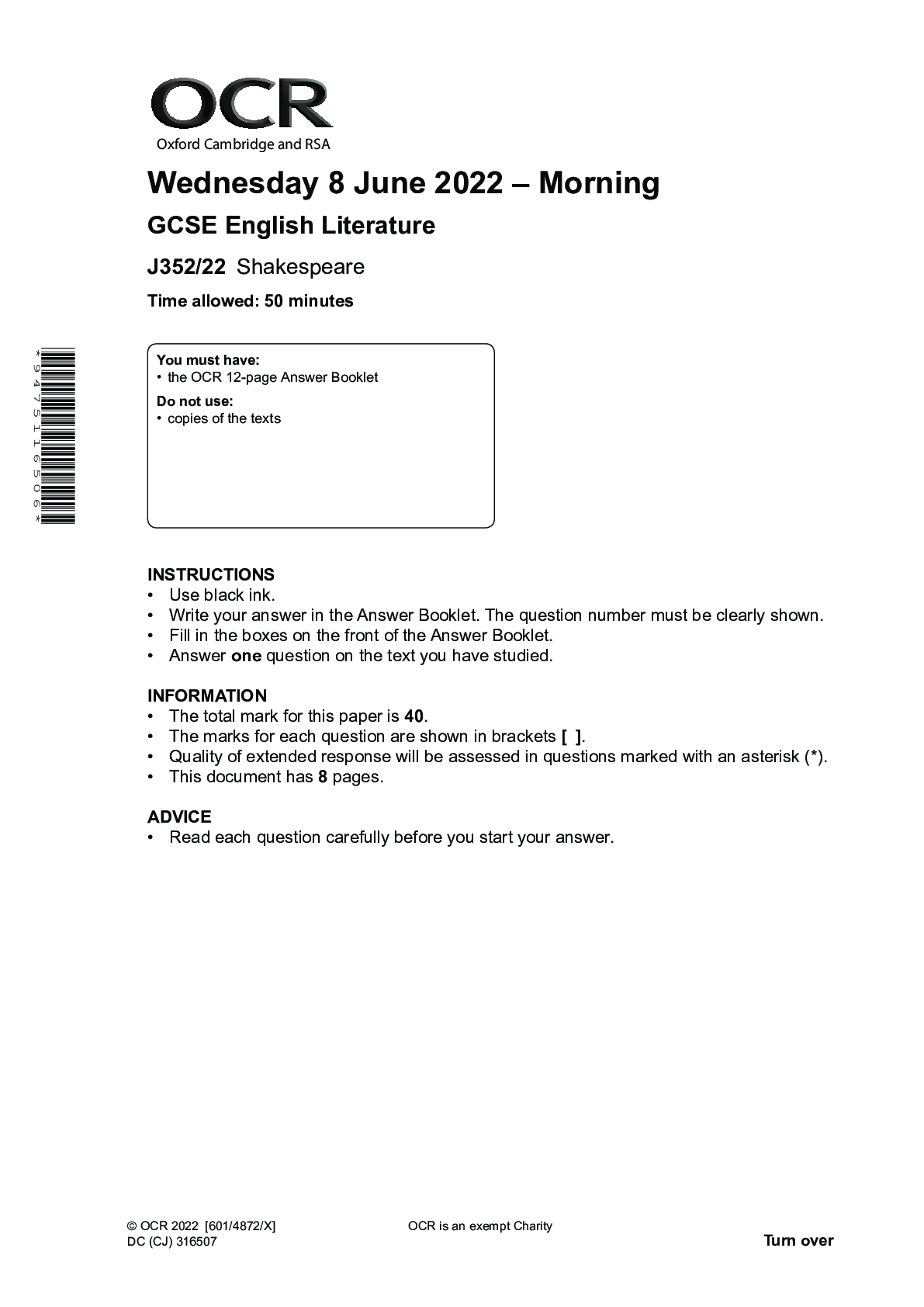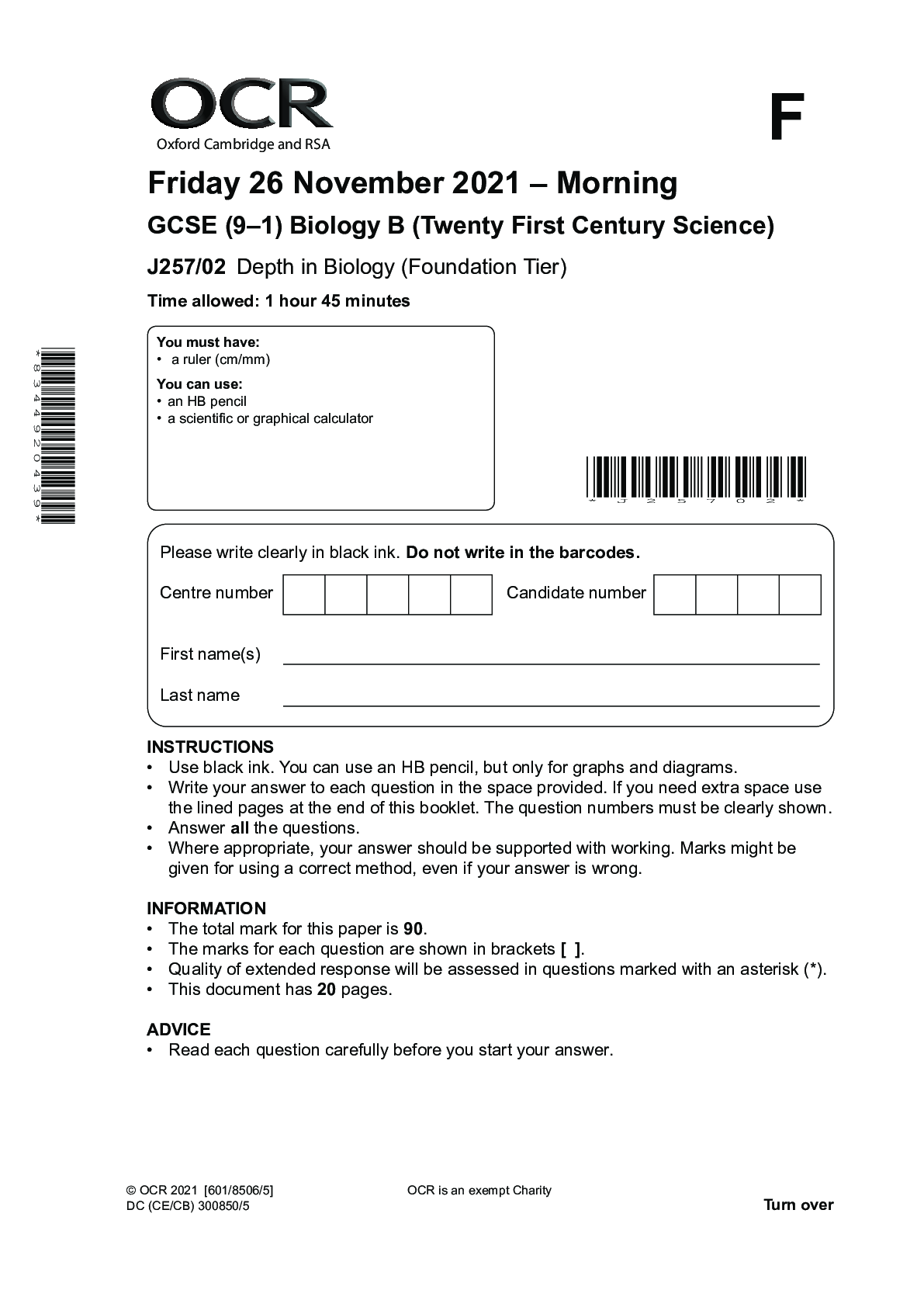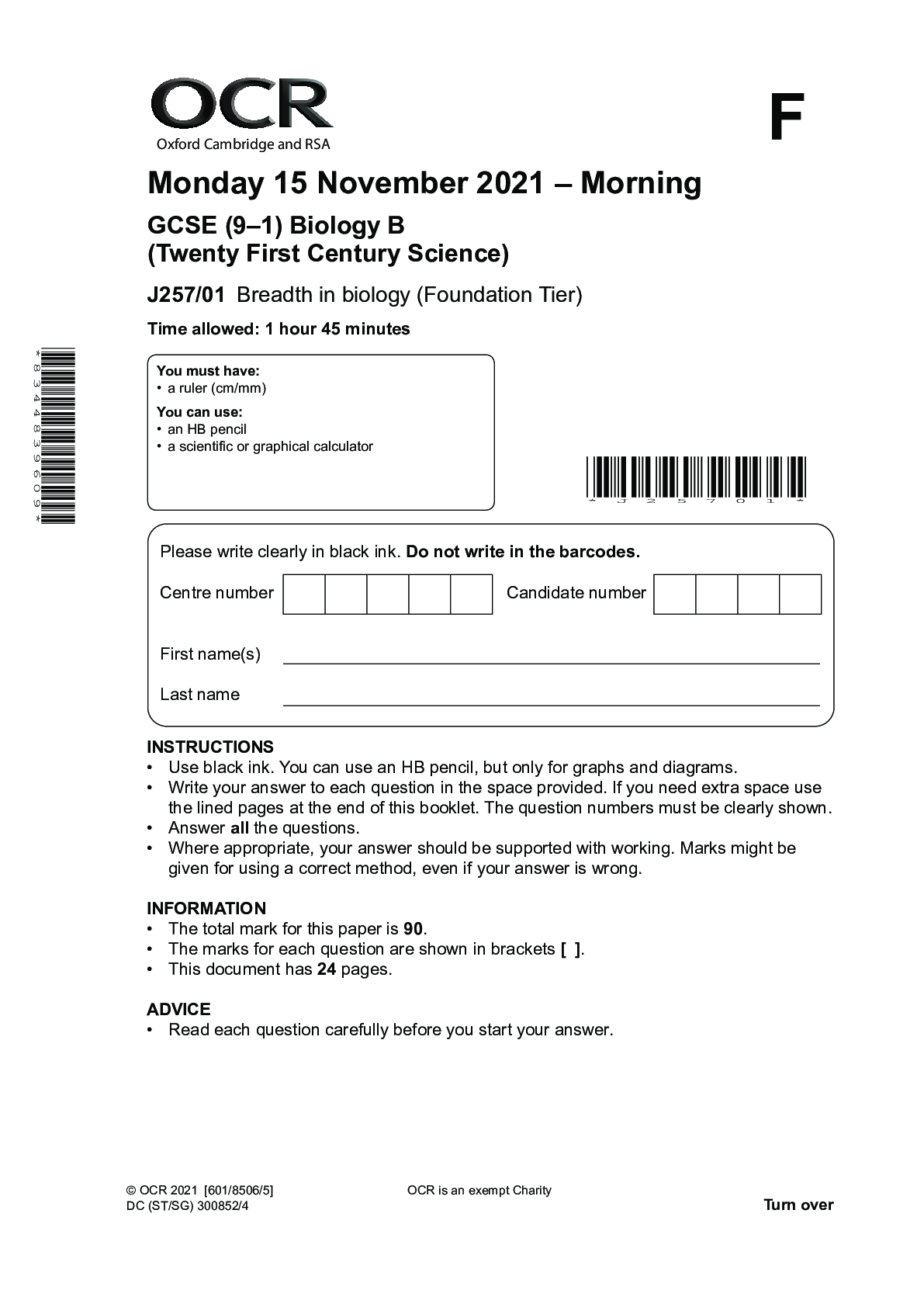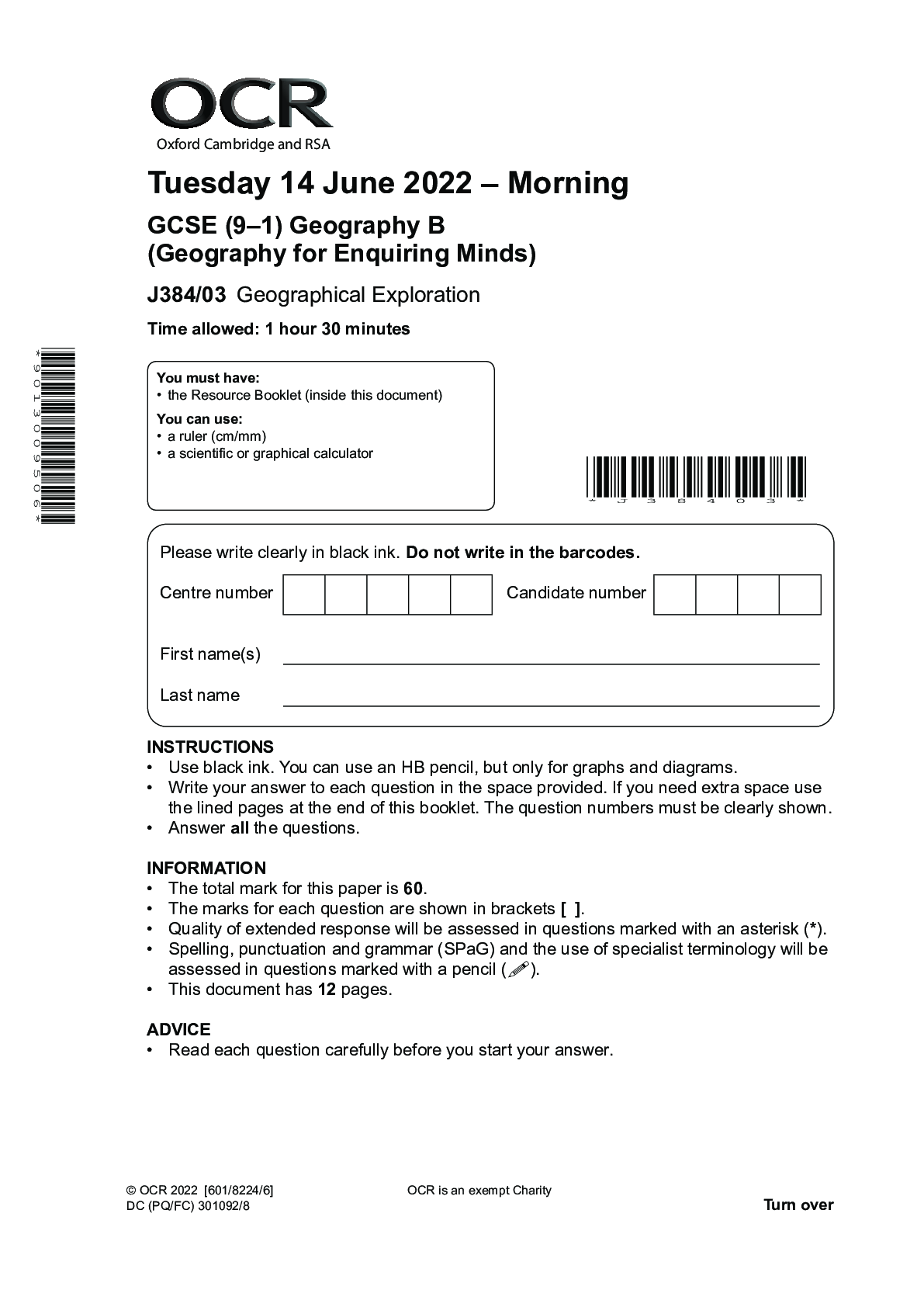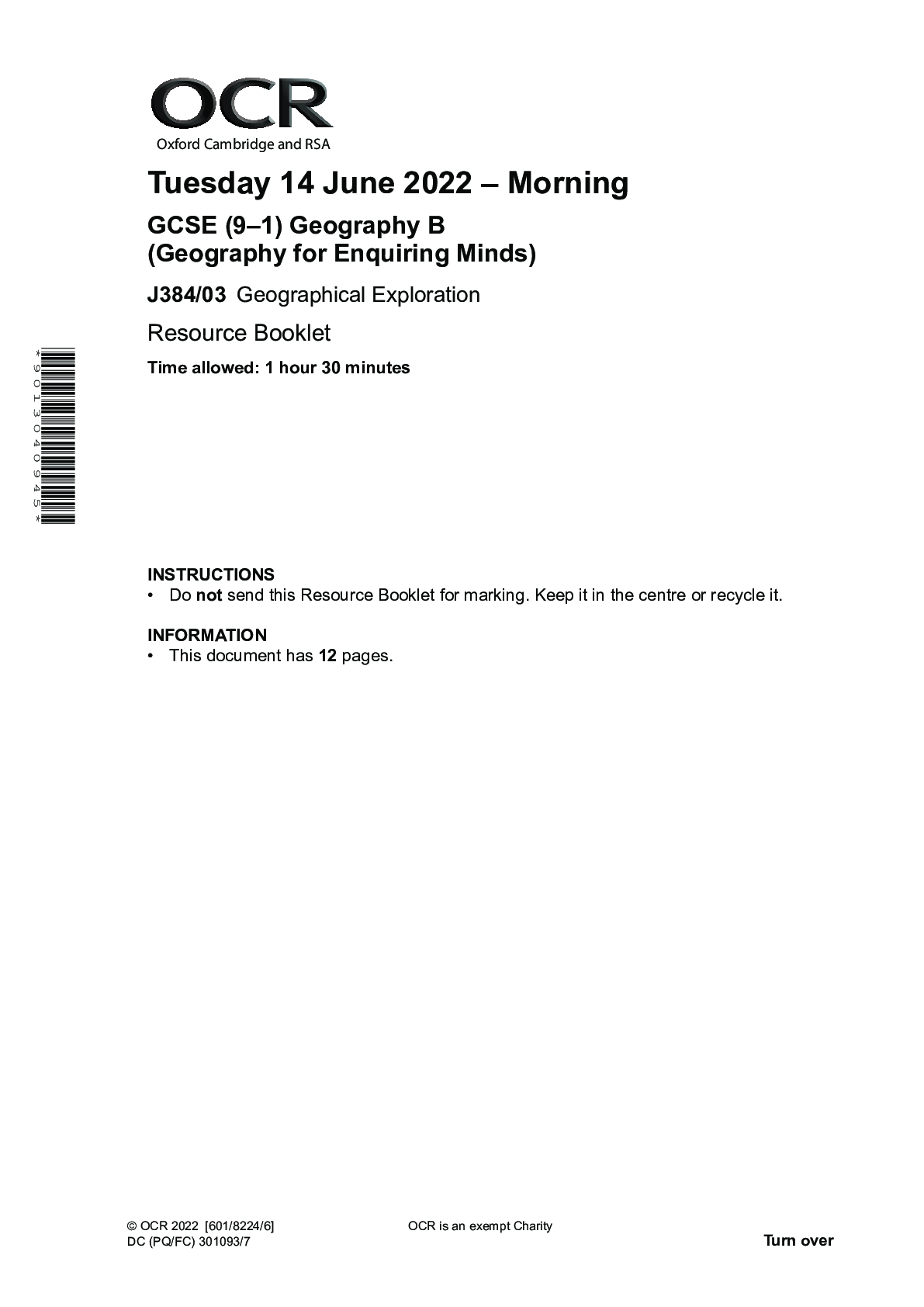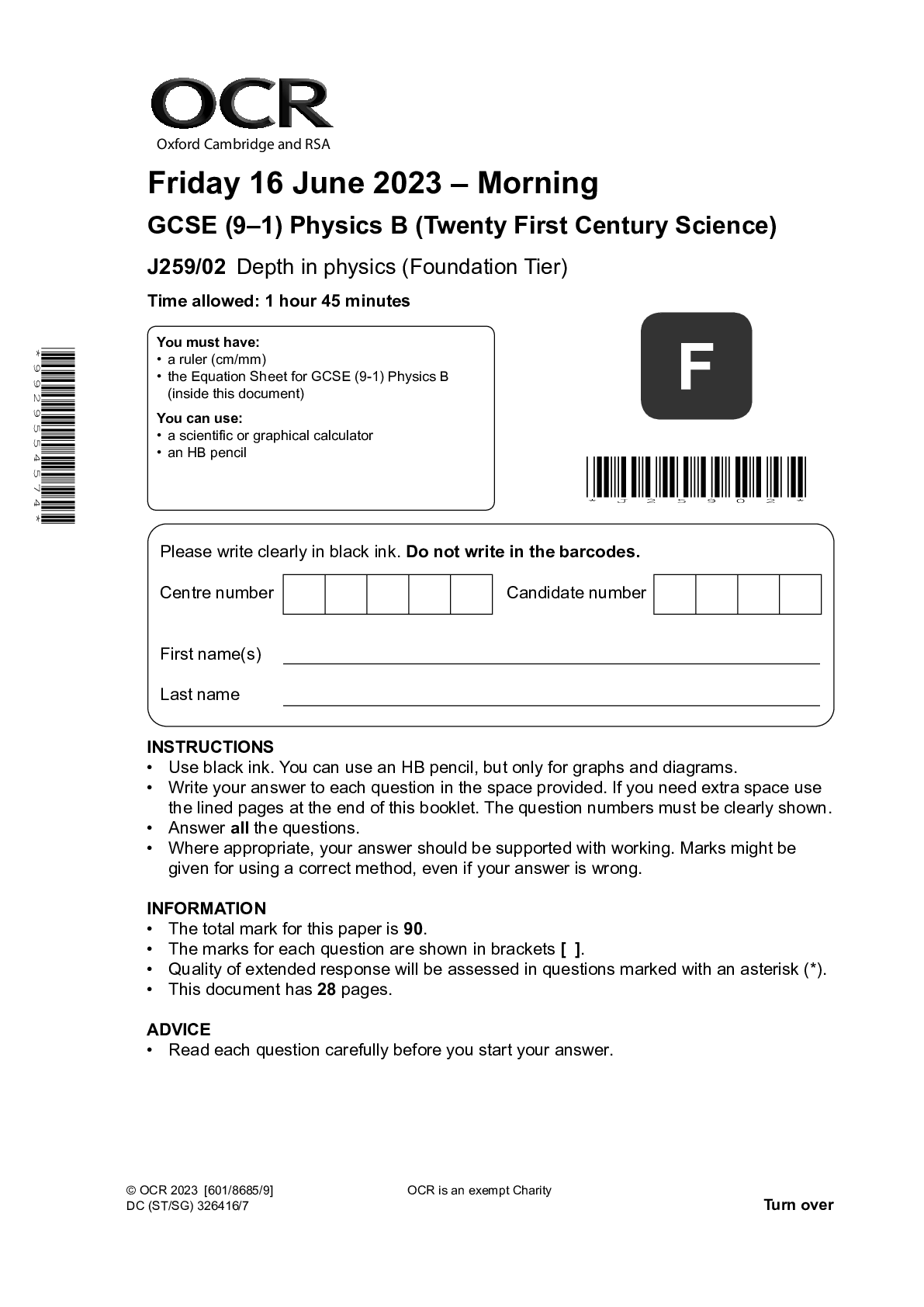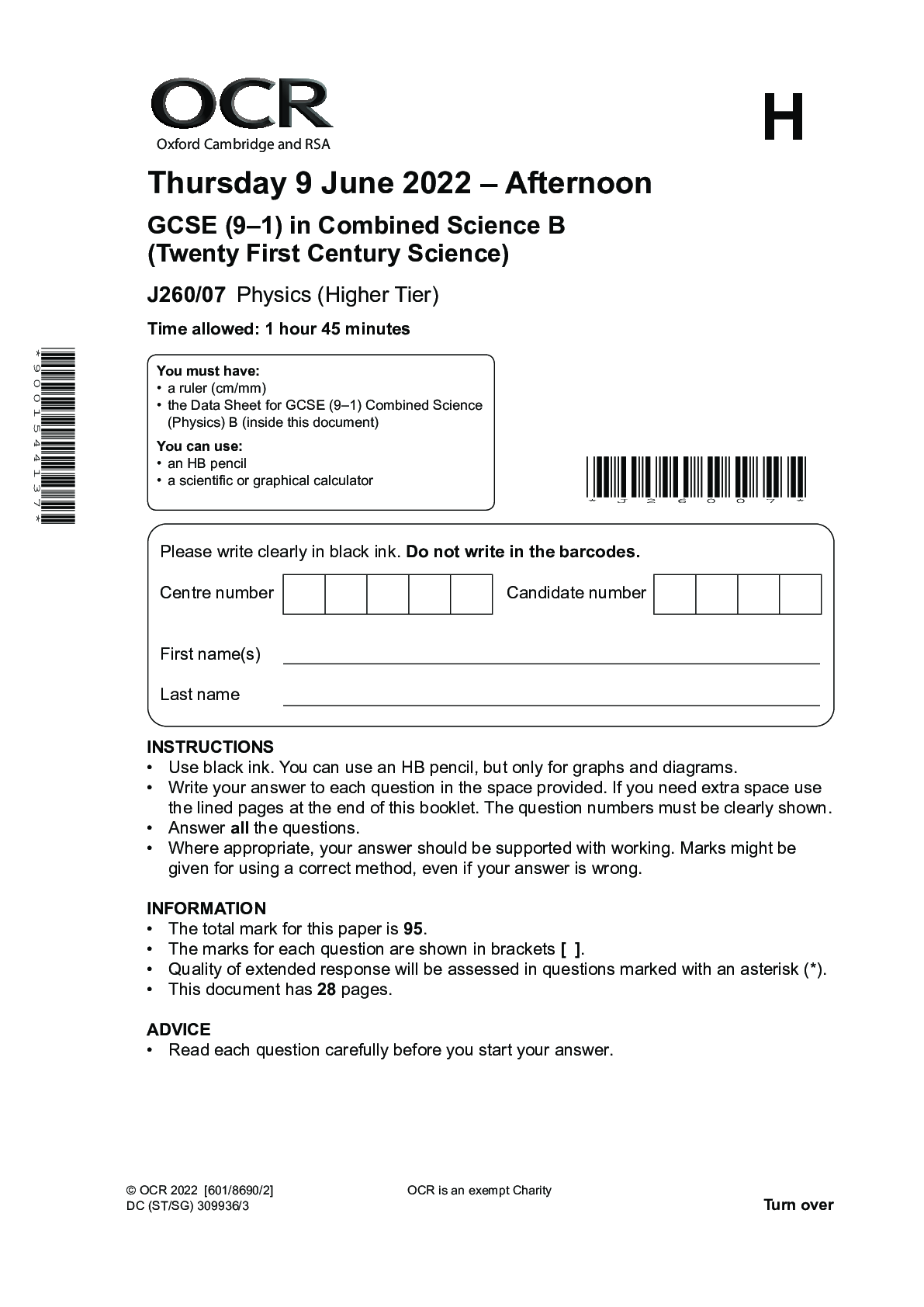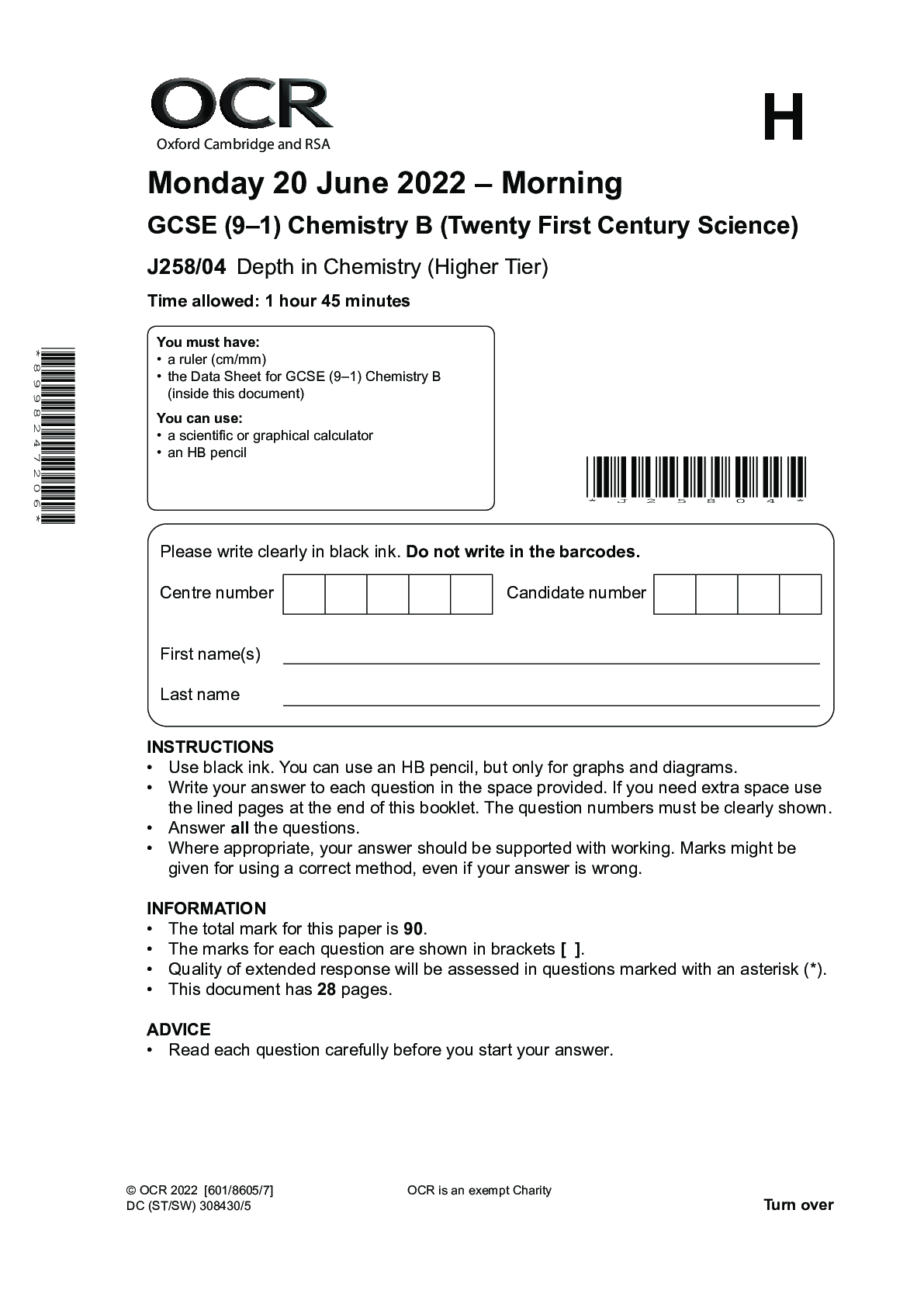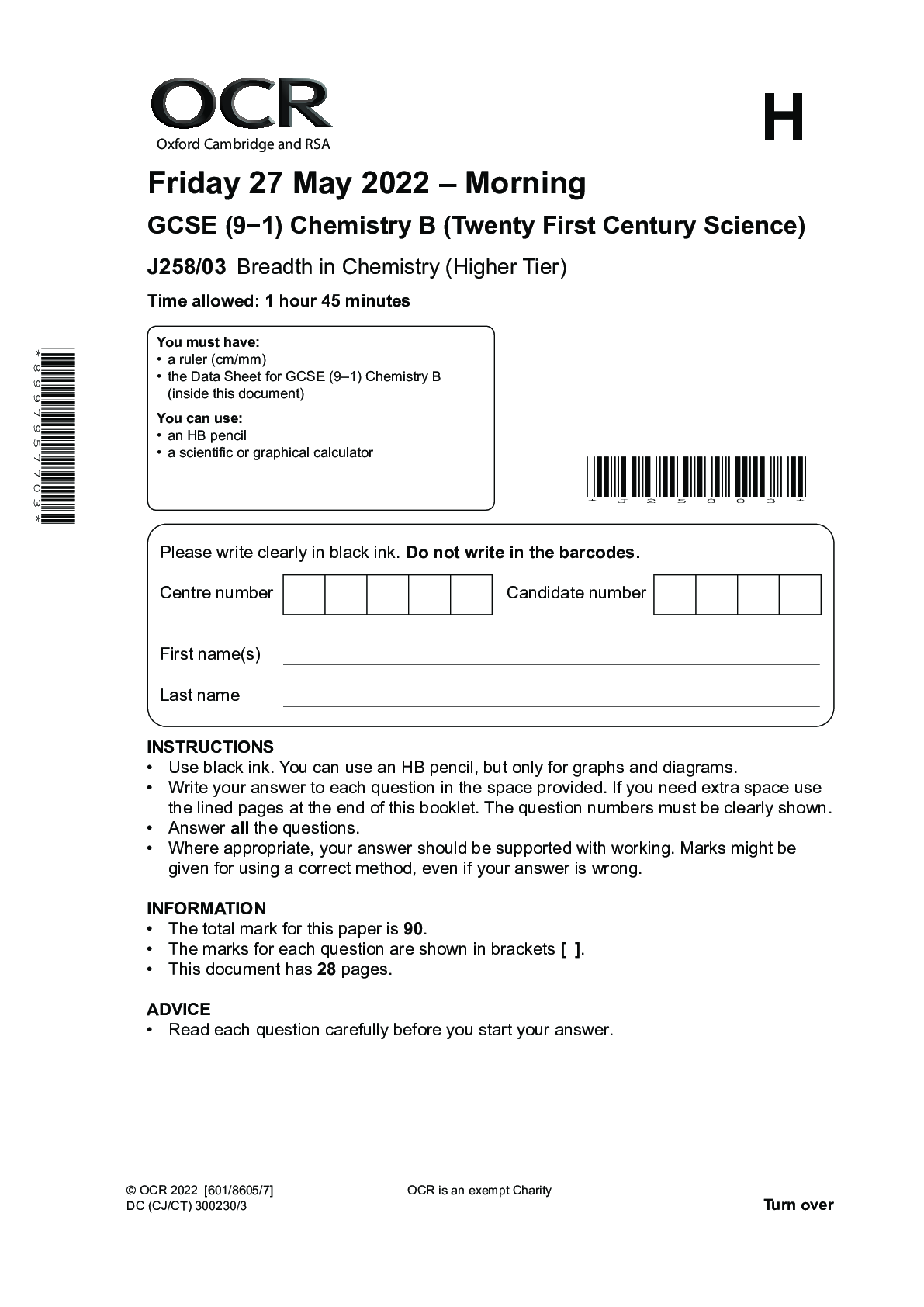Combined Science: Synergy > QUESTION PAPER (QP) > OCR Oxford Cambridge and RSA Friday 27 May 2022 - Morning GCSE (9—1) Combined Science B (Twenty Fi (All)
OCR Oxford Cambridge and RSA Friday 27 May 2022 - Morning GCSE (9—1) Combined Science B (Twenty First Century Science) J260/06 Chemistry (Higher Tier)
Document Content and Description Below
INSTRUCTIONS • Use black ink. You can use an HB pencil, but only for graphs and diagrams. • Write your answer to each question in the space provided. If you need extra space use the lined page... s at the end of this booklet. The question numbers must be clearly shown. • Answer all the questions. • Where appropriate, your answer should be supported with working. Marks might be given for using a correct method, even if your answer is wrong. INFORMATION • The total mark for this paper is 95. • The marks for each question are shown in brackets [ ]. • Quality of extended response will be assessed in questions marked with an asterisk (*). • This document has 24 pages. ADVICE • Read each question carefully before you start your answer. © OCR 2022 [601/8690/2] DC (ST/CGW) 309916/5 Friday 27 May 2022 – Morning GCSE (9–1) Combined Science B (Twenty First Century Science) J260/06 Chemistry ( Higher Tier) Time allowed: 1 hour 45 minutes 2 © OCR 2022 Answer all the questions. 1 The table gives information about some of the compounds present in crude oil. Number of carbon atoms Molecular formula Empirical formula Melting point (°C) Boiling point (°C) State at room temperature 4 C4H10 C2H5 –138 0 Gas 5 ................... C5H12 –130 36 6 C6H14 C3H7 –95 69 Liquid 7 C7H16 C7H16 –90 Liquid 8 C8H18 ................... –57 126 Liquid (a) (i) Complete the table to show the missing molecular formula and empirical formula. [2] (ii) Predict the boiling point for the compound with 7 carbon atoms. Boiling point = ..................................................... °C [1] (iii) Predict the state of the 5 carbon compound at room temperature (20°C). Explain your answer. State .................................................. Explanation ....................................................................................................................... ........................................................................................................................................... ........................................................................................................................................... [2] 3 © OCR 2022 Turn over (b) All the compounds in the table are in the same homologous series. All members of a homologous series have the same general formula. (i) Give two other characteristics of a homologous series that are shown in the table. 1 ........................................................................................................................................ ........................................................................................................................................... 2 ........................................................................................................................................ ........................................................................................................................................... [2] (ii) Complete the sentences to describe the compounds present in crude oil that are shown in the table. Put a ring around each correct answer. Crude oil is a mixture of hydrocarbons / polymers / salts. The compounds are from the homologous series allotropes / alkanes / alkenes. They all have the general formula CnH2n / CnH2n+1 / CnH2n+2. [3] 4 © OCR 2022 2 Solid calcium carbonate reacts with dilute hydrochloric acid to form calcium chloride, carbon dioxide and water. CaCO3(s) + 2HCl(aq) CaCl 2(aq) + CO2(g) + H2O(l) (a) Jane investigates the rate of this reaction. She measures the change in mass during the reaction over five minutes. She uses 10g of calcium carbonate lumps and 50cm3 of dilute hydrochloric acid. The graph shows Jane’s results. 0 150.0 150.5 151.0 Mass (g) 151.5 152.0 152.5 153.0 50 100 150 200 Time(s) 250 300 350 5 © OCR 2022 Turn over (i) What was the time taken for the reaction to finish? ........................................................ s [1] (ii) What was the total mass lost during the reaction? Total mass lost = ........................................................ g [2] (iii) Calculate the average rate of the reaction. Rate of reaction = .................................................... g/s [2] (b) Jane repeats the experiment with 10g of calcium carbonate powder instead of 10g of lumps. She keeps everything else the same. Sketch a line on the graph to show the results she should expect. [2] (c) Complete the sentences to explain why the rate of reaction changes when powdered calcium carbonate is used instead of lumps. Put a ring around each correct answer. The surface area of 10g of powdered calcium carbonate is larger than / smaller than / the same as 10g of lumps. The total volume of 10g of powdered calcium carbonate is larger than / smaller than / the same as 10g of lumps. [2] 6 © OCR 2022 3 Calcium is a metal in Group 2 of the Periodic Table. Chlorine is a non-metal in Group 17(7) of the Periodic Table. Table 3.1 shows some properties of calcium and chlorine. Property Calcium Chlorine Type of ions formed positive negative Electrical conductivity good none Boiling point (°C) 1484 –35 Table 3.1 (a) Describe one other property, not shown in Table 3.1, which is different for metals and non-metals. ................................................................................................................................................... .............................................................................................................................................. [1] (b) The difference in properties of metals and non-metals is caused by their electronic structures. (i) Give the electronic structures of calcium and chlorine. Calcium ............................................................................................................................. Chlorine ............................................................................................................................. [2] (ii) Explain why calcium and chlorine form different types of ions. ........................................................................................................................................... ........................................................................................................................................... ........................................................................................................................................... ........................................................................................................................................... ........................................................................................................................................... ...................................................................................................................................... [3] 7 © OCR 2022 Turn over (c) (i) The boiling points of calcium and chlorine are different because of the forces of attraction between particles. Draw lines to connect each element to the forces of attraction between its particles. Element Forces of attraction [2] (ii) Explain why the boiling points of calcium and chlorine are different. Use your answer to (i) to support your answer. ........................................................................................................................................... ........................................................................................................................................... ........................................................................................................................................... ...................................................................................................................................... [2] Calcium Chlorine between atoms between ions between molecules between positive ions and delocalised electrons 8 © OCR 2022 (d) Metals and non-metals react together to form ionic compounds. Table 3.2 shows some information about three ionic compounds. Ionic Compound Ions Formula Sodium chloride Na+ and Cl – NaCl Potassium oxide ............................. K2O Aluminium oxide Al 3+ and O2– ............................. Table 3.2 Complete the table to show the ions in potassium oxide and the formula of aluminium oxide. [2] (e) Metals and ionic compounds can form lattices. The diagram shows four different lattice structures. A B C D (i) Which two structures are the lattice of a metal? Structures ............. and ............. [1] (ii) Which structure is the lattice of potassium oxide (K2O)? Explain your answer. Structure ............. Explanation ....................................................................................................................... ........................................................................................................................................... [2] 9 © OCR 2022 Turn over BLANK PAGE PLEASE DO NOT WRITE ON THIS PAGE 10 © OCR 2022 4 Ovenshine is used as an oven cleaner. The label gives information about the product. OVENSHINE Contents: 5 to <12% sodium hydroxide Hazards: corrosive Avoid contact with aluminium (a) (i) Complete the balanced symbol equation for the reaction of aluminium with sodium hydroxide. ..............Al + 2NaOH + ..............H2O ..............NaAlO2 + ..............H2 [1] (ii) How does the equation show that contact with aluminium surfaces is a hazard? ........................................................................................................................................... ........................................................................................................................................... ........................................................................................................................................... ...................................................................................................................................... [2] (b) Tests can be used to identify gases produced in a reaction. Complete the table to show the method and the result for the tests for the three gases. Gas Method Result hydrogen ..................................................... ..................................................... carbon dioxide ..................................................... ..................................................... oxygen ..................................................... ..................................................... [3] 11 © OCR 2022 Turn over (c) Sam does a titration to find the amount of sodium hydroxide in the oven cleaner. This is the method: • Measure out 3.00g of the cleaner into a conical flask • Add a few drops of indicator • Add 0.25mol/dm3 hydrochloric acid until all of the sodium hydroxide has reacted. The equation shows the reaction of sodium hydroxide with hydrochloric acid. NaOH(aq) + HCl(aq) NaCl(aq) + H2O(l) (i) Calculate the range of the mass of sodium hydroxide expected in 3g of oven cleaner. Use information from the label. Mass of sodium hydroxide is from .................... g to < .................... g [3] (ii) How does Sam know when all the sodium hydroxide has reacted? ........................................................................................................................................... ...................................................................................................................................... [1] (iii) Sam wants to measure the exact volume of acid needed for all of the sodium hydroxide to react. Describe one thing Sam should do so that the titration result is accurate. ........................................................................................................................................... ...................................................................................................................................... [1] 12 © OCR 2022 (d) Sam finds that 24.8cm3 of 0.25mol/dm3 hydrochloric acid is needed to react with the sodium hydroxide in 3.00g of oven cleaner. (i) Calculate the number of moles of hydrochloric acid in 24.8cm3 of 0.25mol/dm3. Use the formula: concentration (mol/dm3) = number of moles of solute volume (dm3) Number of moles of acid = ........................................................... [3] (ii) Find out how many moles of sodium hydroxide react with this amount of acid. Use the symbol equation: NaOH(aq) + HCl(aq) NaCl(aq) + H2O(l) Number of moles of sodium hydroxide = ........................................................... [1] (iii) Calculate the mass of sodium hydroxide (NaOH) reacting with the acid. Use the formula and the relative atomic masses given. number of moles = mass of substance (g) relative formula mass (g) Relative atomic masses: Na = 23.0, O = 16.0, H = 1.0 [Show More]
Last updated: 1 year ago
Preview 1 out of 24 pages
Instant download

Instant download
Reviews( 0 )
Document information
Connected school, study & course
About the document
Uploaded On
Apr 03, 2023
Number of pages
24
Written in
Additional information
This document has been written for:
Uploaded
Apr 03, 2023
Downloads
0
Views
78

